Abstract
The tortricid mothEpiblema strenuana (Walker), which attacksAmbrosia spp. over most of North America, is shown to have the annual weedParthenium hysterophorus L. [Compositae] as its main host in northern Mexico. The larvae produce galls in the stems and growing-points which can considerably stunt growth when young plants are attacked. In tests it was shown to have a restricted host-range and not to damage any composite of economic importance. Its release in Australia for trial as a biological control agent againstP. hysterophorus has been approved.
Resumen
Se encontró que el tortricidoEpiblema strenuana, que atacaAmbrosia spp. en la mayor parte de Norteamérica, utiliza aParthenium hysterophorus como hospedera principal en el norte de México. Las larvas producen agallas en el tallo y en las yemas, y pueden ocasionar una considerable inhibición en el crecimiento al atacar plantas jóvenes. En pruebas se encontró que el insecto tiene un rango restringido en hospederas y que no es capaz de dañar ninguna planta de importancia económica dentro de la familia de las compuestas. Se ha autorizado su liberación en Australia para probar su eficacia como agente de control biológico contraP. hysterophorus.
Résumé
La tordeuseEpiblema strenuana, qui attaque les espèces du genreAmbrosia dans la majeure partie de l'Amérique du nord, utiliseParthenium hysterophorus [Compositae] comme principal hôte dans la région nord du Mexique. Les larves produisent des galles dans les tiges et les bourgeons, qui peuvent arrêter la croissance quand les jeunes plantes sont attaquées. Les essais ont montré la gamme limitée d'hôtes, dont sont exclues toutes composées d'importance économique, que possède la tordeuse. Son introduction en Australie comme agent de lutte biologique contreP. hysterophorus a été approuvée.
Similar content being viewed by others
References
Blanchard, A.—1979. New status forEpiblema minutana (Kearfott) and new species ofEpiblema Hubner andSonia Heinrich [Tortricidae].—J. Lepid. Soc., 33, 179–188.
Brown, R.L.—1973. Phylogenetic systematics: its application to the genusEpiblema.—Unpublished MS thesis, University of Arkansas.
Brown, R.L.—1979. Nomenclatorial changes inEucosmini [Tortricidae].—J. Lepid. Soc., 33, 21–28.
Correll, D.S. &Johnston, M.C.—1970. Manual of the vascular plants of Texas.—Texas Research Foundation, Renner, Texas, pp. xiii+1881.
Fernald, M.L.—1950. Gray's Manual of Botany. 8th edition. Reprinted 1970.—Van Nostrand, New York. pp. lxiv+1632.
García Martell, C.—1977. Lista de insectos y ácaros perjudiciales a los cultivos en México.—Fitófilo, 73, 1–163.
Goeden, R.D. &Ricker, D.W.—1974a. The phytophagous insect fauna of the ragweed,Ambrosia acanthicarpa, in Southern California.—Environ. Entomol., 3, 827–834.
Goeden, R.D. &Ricker, D.W.—1974b. The phytophagous insect fauna of the ragweed,Ambrosia chamissonis, in Southern California.—Environ. Entomol., 3, 835–839.
Goeden, R.D. &Ricker, D.W.—1975. The phytophagous insect fauna of the ragweed,Ambrosia confertiflora, in Southern California.—Environ. Entomol., 4, 301–306.
Goeden, R.D. &Ricker, D.W.—1976. The phytophagous insect fauna of the ragweed,Ambrosia psilostachya, in Southern California.—Environ. Entomol., 5, 1169–1177.
Harley, K.L.S. &Willson, B.W.—1968. Propagation of a cerambycid borer on a meridic diet.—Can. J. Zool., 46, 1265–1266.
Haseler, W.H.—1976.Parthenium hysterophorus L. in Australia.—PANS, 22, 515–517.
Heinrich, C.—1923. Revision of the North American moths of the subfamilyEucosminae of the familyOlethreutidae.—Bull. US. Natl. Mus., 123, 1–298.
Herting, B.—1975. A catalogue of the parasites and predators of terrestrial arthropods. Section A, Vol. VI,Lepidoptera, Part [Microlepidoptera].Commonw. Agric. Bureaux, Slough, England, pp. 218.
Krombein, K.V., Hurd, P.D., Jr., Smith, D.R. &Burks, B.D.—1979. Catalog of Hymenoptera in America north of Mexico.—Smithsonian Institution Press, Washington, D.C. 3 vols.
Hilgendorf, J.A. &Goeden, R.D.—1981. Phytophagous insects reported from cultivated and weedy varieties of the sunflower,Helianthus annuus, in North America.—Bull. Entomol. Soc. Am., 27, 102–108.
Mackay, M.R.—1959. Larvae of the North AmericanOlethreutidae [Lepidoptera].—Can. Entomol., Suppl. 10, 1–338.
McFadyen, R.E.—1985. The biological control programme againstParthenium hysterophorus in Queensland.—Proc. VI Int. Symp. Biol. Control Weeds, Vancouver 19–25 August 1984, 789–796.
Miller, W.E.—1976. Biology and taxonomy of three gall-forming species ofEpiblema [Olethreutidae]. —J. Lepid. Soc., 30, 50–58.
Miller, W.E. &Pogue, M.G.—1984. Ragweed borer [Lepidoptera: Tortricidae: Eucosmini]: Taxonomic implications of an allometric analysis of adult characters.—Ann. Entomol. Soc. Am., 77, 227–231.
Muesebeck, C.F.W.—1935. Three new reared parasitic Hymenoptera, with notes on synonymy.—J. Wash. Acad. Sci., 25, 279–283.
Powell, J.A.—1975. Biological records and description of some little knownEpiblema in the southwestern United States.—Pan-Pac. Entomol., 51, 99–112.
Rathcke, B.J.—1976. Competition and co-existence within a guild of herbivorous insects.—Ecology, 57, 76–87.
Rice, P.L.—1935. Notes on the ragweed borer [Epiblema strenuana Walker] and its parasites.—Trans. Peninsula Hort. Soc., 1935, 89–94.
Rollins, R.C.—1950. The guayule rubber plant and its relatives.—Contrib. Gray Herb. Harv. Univ., 172, 1–72.
Stegmaier, C.E., Jr.—1971. Lepidoptera. Diptera and Hymenoptera associated withAmbrosia artemisiifolia [Compositae] in Florida.—Fla. Entomol., 54, 259–272.
Thompson, W.R.—1946. A catalogue of the parasites and predators of insect pests. Section I, Part VI: Parasites of the Lepidoptera (CI-F).—Imperial Parasite Service, Bellevue, Ontario, Canada, pp. 131–258.
Towers, G.H.N., Mitchell, J.C., Rodriguez, E., Bennett, F.D. &Subba Rao, P.C.—1977. Biology, and chemistry ofParthenium hysterophorus, a problem weed in India.—J. Sci. Ind. Res., 36, 672–684.
Author information
Authors and Affiliations
Rights and permissions
About this article
Cite this article
McClay, A.S. Observations on the biology and host specificity ofEpiblema strenuana [Lepidoptera, Tortricidae], a potential biocontrol agent forParthenium hysterophorus [Compositae] . Entomophaga 32, 23–34 (1987). https://doi.org/10.1007/BF02390928
Received:
Accepted:
Issue Date:
DOI: https://doi.org/10.1007/BF02390928




